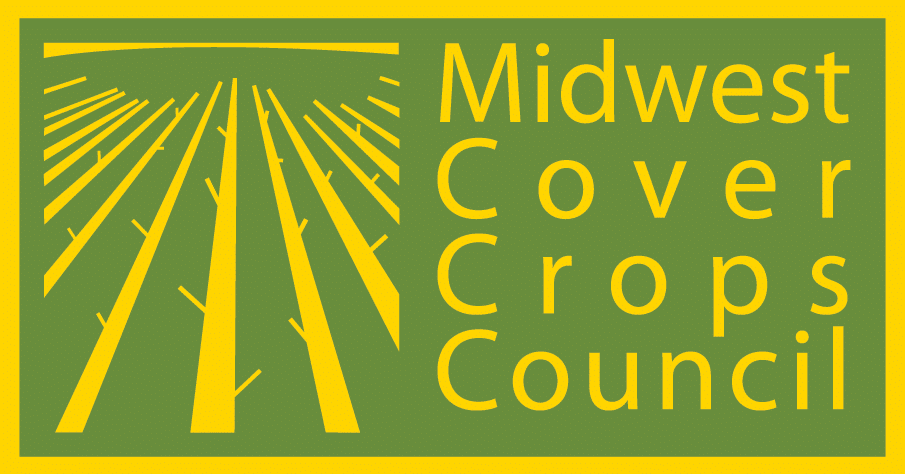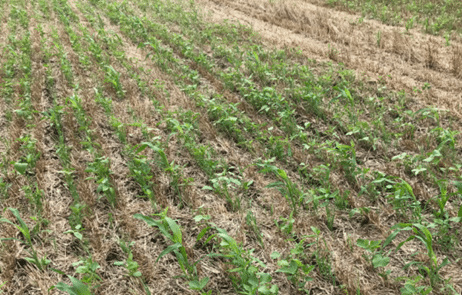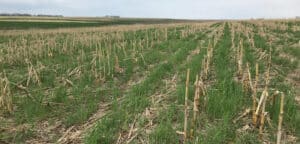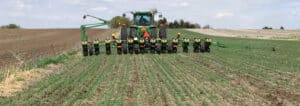Midwest Cover Crops Council (MCCC-136)
University of Nebraska Extension (G2351)
This publication is intended to provide a starting point for farmers who are new to growing cover crops. With experience, farmers may fine-tune the use of cover crops for their systems.
Introduction
This publication provides an introductory approach to integrating cover crops following corn silage and before corn or soybeans. These cover crops can have many benefits, such as erosion control, weed suppression, improved soil health, and quality forage production.
Planning and Preparation
- Planning—Start planning early. Educate yourself by talking to experienced cover crop users, attending conferences and field days, and reading as much as possible about cover crops. Start small and determine your purpose and objectives for using cover crops. If needed, arrange for equipment, additional labor, or custom operators.
- Corn hybrid and planting—Plant the corn silage crop early and use a hybrid within the adapted maturity range for your location. This will allow you to plant your cover crop earlier and increase fall growth.
- Residual corn herbicides—Consult your agricultural supplier regarding residual corn herbicides that could cause concerns for newly planted cover crops. Cereal grains (rye, oats, and wheat) are not affected by most pre-emergence residual herbicides but are somewhat affected by post-emergence herbicides. If using rapeseed in your mix, it may be sensitive to carryover from herbicides. If cover crops will be grazed, additional herbicide restrictions may apply.
- Seed purchase—Order your seed early from a reputable seed supplier to ensure a good germination rate, purity of seed, and that all seed has a seed analysis tag. Specific varieties of cereal rye, wheat, or oats may produce significantly more growth, but they are also more expensive than variety not stated (VNS) seed.
Fall Work
- Corn silage harvest—Harvest fields where a cover crop is to be planted first, if possible.
- Tillage or no-tillage—No-till drilling into corn silage stubble is usually the best strategy to use unless tillage is necessary to incorporate manure, fertilizer, or lime, or needed to smooth out the seedbed, such as deep wheel tracks after corn silage harvest. The tillage should be completed as soon as possible and before seeding the cover crop.
- Timing of planting—Ideally, plant your cover crop as soon as possible after silage harvest. Plant the oats cover crop mix or oats alone by Sept. 7. Oats will not grow enough to justify their use after this date. For winter wheat only, plant before 50% frost date. For rye only, plant before two weeks after the 50% frost date. In northern Nebraska, this would be before Oct.15; in southern Nebraska, before Nov. 1. Use the Cover Crop Selector Tool (in the Resources section) for more precise dates for your county. These dates are guidelines; the sooner these cover crops are planted in the fall, the better.
- Seeding rate for a mix—Drilled: oats, 20 lbs./acre; wheat, triticale, or rye, 25 lbs./acre; rapeseed, 1 lb./acre. Broadcast: oats, 25 lbs./acre; wheat, triticale, or rye, 30 lbs./acre; rapeseed, 2 lbs./acre.
- Seeding rate for oats alone—Drilled: 30–40 lbs./acre; if grazed, 40–55 lbs./acre.
- Seeding rate for wheat or rye alone—25–35 lbs./acre; if grazed, 45–60 lbs./acre. Shallow incorporation: oats, 45–60 lbs./acre; wheat, 50–65 lbs./acre; rye, 50–65 lbs./acre.
- Planting method—If you include the brassica rapeseed, seeding depth is limited as these are small seeds. A depth of 0.50 inch is best. If you have a drill with two boxes, you can dribble the rapeseed on top of the ground and then drill your cereal grain to a depth of 0.75–1.50 inches.
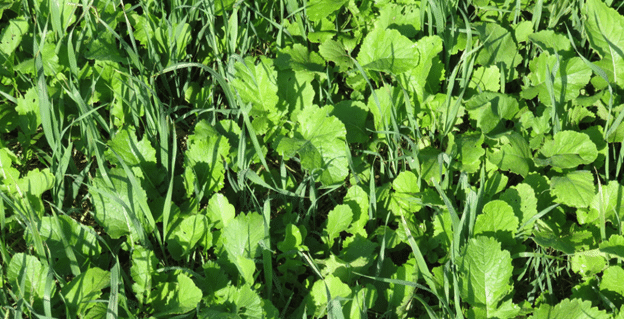
Spring Work
- Termination timing—Oats and rapeseed will usually winter-kill. Terminate the wheat, triticale, or cereal rye in the spring when plants are 6–12 inches tall and actively growing or about two weeks before planting corn or soybeans—whichever comes first. Many experienced growers will terminate wheat, triticale, or cereal rye the same day as planting corn or soybean, or within one week, particularly in irrigated situations. This provides an extra benefit for weed control. Risk of wheat stem maggot damage to corn seedlings increases when corn is planted into a green, non-terminated, winter cereal grain cover crop. Another concern is that cover crop residue with a high carbon-to-N (C:N) ratio can reduce soil-available N. Starter N fertilizer is recommended at planting or sidedress as soon as possible to offset this early immobilization when the corn has a high N demand. New cover crop users should terminate earlier when the cereal crops are smaller for corn. Planting green into soybeans is much less risky and could be implemented by new cover crop users.
- Termination herbicide—Wheat, triticale, and cereal rye can typically be terminated with a full rate of glyphosate (1 lb. acid equivalent/acre) after these crops begin growing in the spring. Effectiveness and rapidity of termination improve if winter cereal grain grows rapidly and air temperatures are warmer.
- Termination modifications for dry weather—Watch the weather and be ready to modify your termination plans. In a dry spring, cereal grain crops have the potential to use moisture that the cash crop will need, so terminate cover crops sooner to allow rainfall to make up the deficit.
- Termination modifications for wet weather—In a wet spring, be ready to take advantage of any break in the weather and/or use low axle weight sprayers.
- Option to harvest cereal rye, wheat, or triticale as a silage crop—A cereal grain cover crop planted in the fall and harvested at boot stage can provide a substantial amount of good quality forage. Waiting for the cereal grain cover crop to reach the boot stage (mid-May to early June) will delay planting of the next corn or soybean crop. If this crop is to be insured, then the small-grain cover crop should be terminated and corn or soybeans planted before the crop insurance late-planting deadline.
- Corn or soybean planting—Almost all modern planters and drills are fully capable of planting corn or soybeans into a clean, small-grain cover crop. Planter adjustments are usually needed to ensure correct planting depth and seed furrow closure.
- Scouting after planting—Scout for corn or soybean emergence, population, and insect pests (e.g., wheat stem maggot in corn). Scout for weeds because substantial small-grain residue, especially cereal rye, can delay emergence of annual weeds, which may then delay the need for and timing of applying post-emergence herbicides.
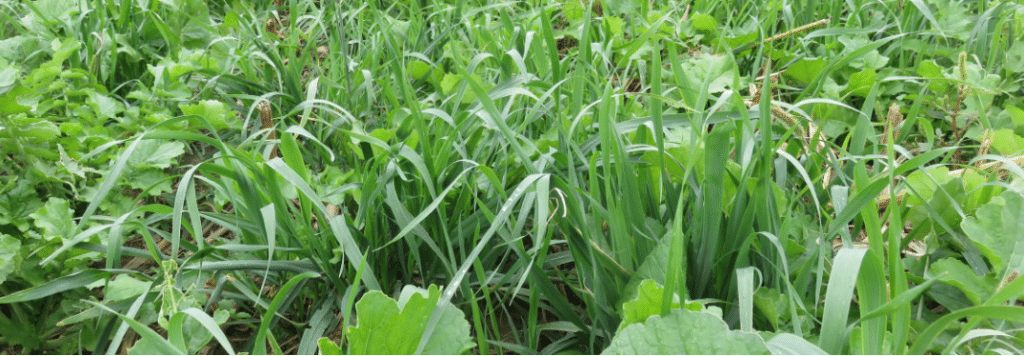
Resources
Cover Crop Selector Tool —available from the Midwest Cover Crops Council, https://www.midwestcovercrops.org
Post Corn, Going to Soybean: Use Cereal Rye (Nebraska Cover Crop Recipe series, MCCC-107)
Post Corn Silage, Going to Corn: Use Cereal Rye (Iowa Cover Crop Recipe series, MCCC-121)
Post Corn Silage, Going to Soybean: Use Cereal Rye (Iowa Cover Crop Recipe series, MCCC-122)
Managing Residual Herbicides with Cover Crops (Institute of Agriculture and Natural Resources, Univ. of Nebraska)
How Herbicide Labels Restrict Using Cover Crops as Forage (Institute of Agriculture and Natural Resources, Univ. of Nebraska)
Corn and Soybean Herbicide Options for Planting Cover Crops for Forage in Fall (Institute of Agriculture and Natural Resources, Univ. of Nebraska)
Residual Herbicides and Fall Cover Crop Establishment (Purdue Extension Weed Science publication)
Terminating Cover Crops: Successful Cover Crop Termination with Herbicides (Purdue Extension publication WS-50-W)
Authors
Gary Lesoing and Katja Koehler-Cole, University of Nebraska-Lincoln (Note: This publication was adapted with consent from MCCC under a joint project to produce customized introductory guidance about cover crops for all member states/provinces.)
Reviewers
Caro Córdova, Nathan Mueller, and Jennifer Rees, University of Nebraska-Lincoln; Eileen Kladivko, Purdue University; Anna Morrow, Midwest Cover Crops Council
The Midwest Cover Crops Council (www.midwestcovercrops.org) aims to facilitate widespread adoption of cover crops throughout the Midwest by providing educational/outreach resources and programs, conducting new research, and communicating about cover crops to the public.
Funding for this project was provided by McKnight Foundation.
December 2022
The U.S. Department of Agriculture (USDA) prohibits discrimination in all its programs and activities on the basis of race, color, national origin, age, disability, and where applicable, sex, marital status, familial status, parental status, religion, sexual orientation, genetic information, political beliefs, reprisal, or because all or a part of an individual’s income is derived from any public assistance program. (Not all prohibited bases apply to all programs.) Persons with disabilities who require alternative means for communication of program information (Braille, large print, audiotape, etc.) should contact USDA’s TARGET Center at (202) 720-2600 (voice and TDD). To file a complaint of discrimination write to USDA, Director, Office of Civil Rights, 1400 Independence Avenue, S.W., Washington, D.C. 20250-9410 or call (800) 795-3272 (voice) or (202) 720-6382 (TDD). USDA is an equal opportunity provider and employer. ©2022 by MCCC. All rights reserved.
